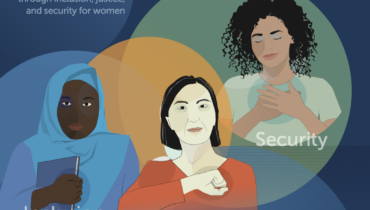A new research collaboration between GIWPS and the Center on Gender Equity and Health at the University of California San Diego (UCSD) offers analyses about the relationship between gender equality and key mortality outcomes for women and children.
The new study, published in the journal Social Science and Medicine – Population Health as part of a special issue on Gender Equality, Empowerment and Health, explores linkages between key health outcomes and the status of women’s wellbeing, as measured by the Women, Peace, and Security (WPS) Index.
Authors Jeni Klugman, Li Li, Kathryn M. Barker, Jennifer Parsons, and Kelly Dale examine whether national performance on the second edition of the WPS Index (which tracks women’s inclusion, justice and security across 167 countries) is associated with two key health outcomes: maternal and infant mortality.
The connection between inclusion, justice, and security & maternal and infant health
Numerous studies investigate the correlates of maternal and infant mortality and highlight shared common factors, including national income and poverty levels, government health spending, and access to clean water and improved sanitation facilities. But what about gender equality?
Author Jeni Klugman notes that: “The WPS Index enables us to assess the extent to which women’s status (for example, whether women attain political representation and whether discrimination against women is legal) and wellbeing (such as whether women are safe from their partners in the home and societal violence at large) also matter to maternal mortality and infant mortality rates.”
The authors use multivariate analysis (controlling for national income) and data from 131 countries. We find that the WPS Index and the inclusion and security sub-indices are significantly and negatively associated with maternal and infant mortality rates. Specifically, a 1 percentage point (.01) increase in the WPS Index is associated with a 2 percent reduction in the number of maternal deaths and a 2.3 percent reduction in the number of infant deaths.
These results emphasize how a comprehensive approach to women’s empowerment and well-being is likely to produce significant gains, in this case in key health outcomes that remain a challenge across many developing countries.
The ongoing toll of maternal and infant mortality
While there have been major reductions in maternal mortality in recent decades, over 800 women each day die from preventable causes related to pregnancy and childbirth, the vast majority in developing countries. Likewise, infant mortality has been on the decline, but in 2017 around 4.1 million infants died before their first birthday.
Many countries with the highest rates of maternal and infant mortality also perform poorly on the WPS index, indicating widespread challenges for women’s rights and wellbeing. These trends can be seen in countries such as Afghanistan, South Sudan and the Central African Republic which have some of the worst maternal mortality rates globally– 1140, 1150, and 829 deaths per 100,000 live births, respectively. In Afghanistan, which ranks 166 out of 167 countries on the WPS Index, women average fewer than two years of schooling and seven out of eight women do not feel safe walking in their neighborhood alone at night in the city. In South Sudan, which ranks 163rd on the WPS index, only 27% of women have access to a mobile phone and less than 5% have a bank account or use mobile money. The Central Africa Republic ranks 160 on the WPS Index and has an organized violence rate (total number of battle deaths from state-based, non-state, and one-sided conflicts per 100,000) of 20.2.
New insights for policymaking and development priorities
While statistical correlation does not prove causation, the analytical results reported in the WPS index suggest important relationships to maternal and child health that should inform policymaking and development priorities. The WPS Index strategically links to priorities laid out in the 2030 Agenda for Sustainable Development and underlines the importance of interconnections and policy coherence.
As Dr. Anita Raj, Director of the Center on Gender Equity and Health at the University of California San Diego and Guest Editor for the special issue in Social Science and Medicine – Population Health notes, “Monitoring progress on gender equality and empowerment requires clear measurement of targets. But while global development is advancing insight into potential targets for change, the science of measurement of gender equality and empowerment remains a nascent field.”
The study demonstrates how the WPS Index can be a powerful tool to help advance the science of measurement of gender equality and empowerment and highlight the importance of working across fields for impactful and lasting change in lives around the world.


